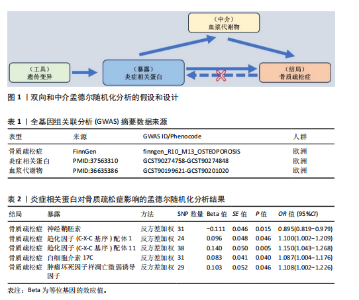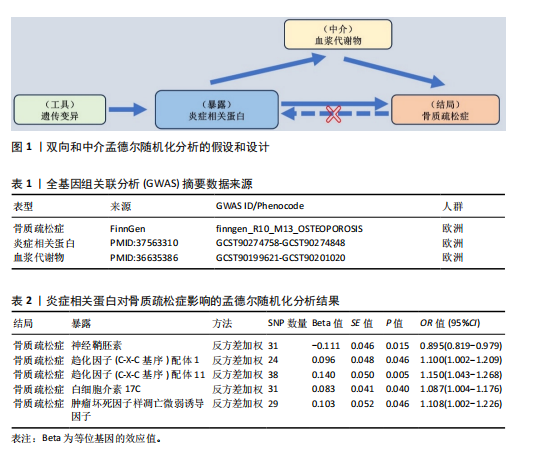Chinese Journal of Tissue Engineering Research ›› 2025, Vol. 29 ›› Issue (17): 3697-3704.doi: 10.12307/2025.651
Previous Articles Next Articles
Inflammation, metabolites and osteoporosis
Lyu Hao1, Zhang Ge2, Hu Zhimu1, Wang Yan1, Chu Qingsong1, Zhou Yao1, Jiang Ting1, Wang Jiuxiang3
- 1First Department of Orthopedics, 3The Experimental Center of Clinical Research, The First Affiliated Hospital of Anhui University of Chinese Medicine, Hefei 230031, Anhui Province, China; 2The Third People’s Hospital of Hefei, Hefei 230031, Anhui Province, China
-
Received:2024-07-17Accepted:2024-08-15Online:2025-06-18Published:2024-11-07 -
Contact:Jiang Ting, MD, Chief physician, Doctoral supervisor, First Department of Orthopedics, The First Affiliated Hospital of Anhui University of Chinese Medicine, Hefei 230031, Anhui Province, China Co-corresponding author: Wang Jiuxiang, MD, Associate researcher, Master’s supervisor, The Experimental Center of Clinical Research, The First Affiliated Hospital of Anhui University of Chinese Medicine, Hefei 230031, Anhui Province, China -
About author:Lyu Hao, MD candidate, The First Department of Orthopedics, The First Affiliated Hospital of Anhui University of Chinese Medicine, Hefei 230031, Anhui Province, China Zhang Ge, The Third People’s Hospital of Hefei, Hefei 230031, Anhui Province, China Lyu Hao and Zhang Ge contributed equally to this work. -
Supported by:Anhui Provincial Natural Science Foundation (General Program), No. 2308085MH294 (to JT); the Key Research and Development Projects in Anhui Province, No. 202104j07020010 (to JT); Natural Science Research (Key Project) of Anhui Provincial Department of Education, No. 2022AH050510 (to JT)

2.1 炎症相关蛋白与骨质疏松症的因果关系 如表2和图2所示,根据反方差加权结果,文章发现神经鞘胚素、趋化因子(C-X-C基序)配体1、趋化因子(C-X-C基序)配体11、白细胞介素17C及肿瘤坏死因子样凋亡微弱诱导因子与骨质疏松症具有因果关系,其中神经鞘胚素(OR=0.895,95%CI:0.819-0.979,P=0.015)与骨质疏松症呈负相关,而趋化因子(C-X-C基序)配体1(OR=1.100,95%CI:1.002-1.209,P=0.046),趋化因子(C-X-C基序)配体11(OR=1.150,95%CI:1.043-1.268,P=0.005),白细胞介素17C (OR=1.087,"


95%CI:1.004-1.176,P=0.040),肿瘤坏死因子样凋亡微弱诱导因子(OR=1.108,95%CI:1.002-1.226,P=0.046)与骨质疏松症呈正相关。表3结果显示经Cochran’s Q检验可知这些单核苷酸多态性之间没有异质性,同时漏斗图显示反方差加权和 MR-egger线左右两边点是大致对称的,见图3。因此,在这些单核苷酸多态性之间的因果关系中,这些单核苷酸多态性之间没有异质性和不对称性。MR-egger截距法和MR PRESSO结果显示,所有P值 > 0.05,且没有检测出离群值,因此,在因果估计中,单核苷酸多态性之间没有水平多效性,见表4。反向孟德尔随机化研究结果显示骨质疏松症对这5个炎症相关蛋白无反向因果影响,所有P值 > 0.05,见表5。 2.2 血浆代谢物中介效应分析结果 首先,在炎症相关蛋白与血浆代谢物的因果关系孟德尔随机化分析中共有316种血浆代谢物与上一部分研究所得的5种炎症相关蛋白[神经鞘胚素、趋化因子(C-X-C基序)配体1、趋化因子(C-X-C基序)配体11、白细胞介素17C和肿瘤坏死因子样凋亡微弱诱导因子]有因果关系,接着对这些血浆代谢物与骨质疏松症进行因果关系的孟德尔随机化分析。根据反方差加权方法,共得到18种血浆代谢物与骨质疏松症相关;接着,分析了这18种血浆代谢物在炎症相关蛋白-骨质疏松症因果通路中的中介效应。如表6,图4,5所示,研究表明1-棕榈酰gpc(16∶0)增加了神经鞘胚素对骨质疏松症的负向作用(暴露与结局孟德尔随机化分析的beta值及中介与结局孟德尔随机化分析的Beta值均为负数,暴露与中介孟德尔随机化分析的beta值为正数),且中介效应比例为0.081(0.027-0.134)。5α-雄甾烷-3α,17β-单硫酸二醇、亚精胺、α-酮戊二酸与琥珀酸比值、脯氨酸与反式-4-羟脯氨酸比值、12,13-二羟基十八碳烯酸、α-酮戊二酸与琥珀酸比值、胡椒碱代谢物C16H19NO3(3)的硫酸盐水平、腺苷3′,5′-环单磷酸腺苷水平的升高均可导致炎症相关蛋白[趋化因子(C-X-C基序)配体1、趋化因子(C-X-C基序)配体11、白细"


胞介素17C和肿瘤坏死因子样凋亡微弱诱导因子]介导的骨质疏松症风险增加。5α-雄甾烷-3α,17β-单硫酸二醇(1)在趋化因子(C-X-C基序)配体1与骨质疏松症因果关系中中介效应比例为0.043(0.005-0.082),在化因子(C-X-C基序)配体11与骨质疏松症因果关系中的中介效应比例为0.030(0.005-0.055)。5α-雄甾烷-3α,17β-单硫酸二醇(2)在趋化因子(C-X-C基序)配体11与骨质疏松症因果关系中中介效应比例为0.041(0.010-0.071)。亚精胺在趋化因子(C-X-C基序)配体11与骨质疏松症因果关系中中介效应比例为0.125(0.058-0.192),Α-酮戊二酸与琥珀酸比值在其中的中介效应比例为0.125(0.058-0.192),脯氨酸与反式-4-羟脯氨酸比值的中介效应比例为0.008(0.020-0.098)。白细胞介素17C与骨质疏松症因果关系中12,13-二羟基十八碳烯酸中介效应比例为0.145(0.067-0.223),Α-酮戊二酸与琥珀酸比值中介效应比例为0.136(0.060-0.212)。肿瘤坏死因子样凋亡微弱诱导因子与骨质疏松症因果关系中胡椒碱代谢物C16H19NO3(3)的硫酸盐水平中介效应比例为0.114(0.048-0.179),腺苷3′,5′-环单磷酸腺苷中介效应比例为0.113(0.041-0.184)。"

| [1] GOPINATH V. Osteoporosis. Med Clin N Am. 2023;107(2):213-225. [2] MUNIYASAMY R, MANJUBALA I. Insights into the mechanism of osteoporosis and the available treatment options. Curr Pharm Biotechno. 2024;25(12):1538-1551. [3] WANG Z, ZHANG X, CHENG X, et al. Inflammation produced by senescent osteocytes mediates age-related bone loss. Front Immunol. 2023;14:1114006. [4] 陈帅,金杰,韩化伟,等.两样本孟德尔随机化分析循环炎症细胞因子与骨密度的因果关联[J].中国组织工程研究,2025, 29(8):1556-1564. [5] XU J, YU L, LIU F, et al. The effect of cytokines on osteoblasts and osteoclasts in bone remodeling in osteoporosis: a review. Front Immunol. 2023;14:1222129. [6] FANG CL, LIU B, WAN M. “Bone-SASP” in skeletal aging. Calcified Tissue Int. 2023;113(1):68-82. [7] GUIJAS C, MONTENEGRO-BURKE JR, WARTH B, et al. Metabolomics activity screening for identifying metabolites that modulate phenotype. Nat Biotechnol. 2018;36(4):316-320. [8] FAN J, JAHED V, KLAVINS K. Metabolomics in bone research. Metabolites. 2021;11(7):434. [9] 张海永,黄景文,谢冰颖,等.骨疏康治疗去卵巢大鼠骨质疏松的腰椎代谢组学分析[J].中国组织工程研究,2022,26(32): 5185-5190. [10] WANG J, WANG Y, ZENG Y, et al. Feature selection approaches identify potential plasma metabolites in postmenopausal osteoporosis patients. Metabolomics. 2022; 18(11):86. [11] 廖欣宇,王福科,王国梁.骨组织工程支架的进展与挑战[J].中国组织工程研究, 2021,25(28):4553-4560. [12] 董佳乐,魏远好,张洪武.基于知识图谱的骨缺损治疗可视化分析[J].中国组织工程研究,2022,26(18):2906-2913. [13] 周宇翔,沈烈军,万诗雨,等.骨免疫调节特性骨组织工程支架在修复骨缺损中的应用和发展[J].中国组织工程研究, 2024,28(29):4734-4740. [14] CHEN Z, XING F, ZHOU Y, et al. Integrated osteoimmunomodulatory strategies based on designing scaffold surface properties in bone regeneration. J Mater Chem B. 2023;11(29):6718-6745. [15] HE J, GAI J. Genome-Wide association studies (GWAS). Methods Mol Biol. 2023; 2638:123-146. [16] BIRNEY E. Mendelian Randomization. Cold Spring Harb Perspect Med. 2022;12(4): a041302. [17] BOWDEN J, HOLMES MV. Meta-analysis and mendelian randomization: a review. Res Synth Methods. 2019;10(4):486-496. [18] ZHAO JH, STACEY D, ERIKSSON N, et al. Genetics of circulating inflammatory proteins identifies drivers of immune-mediated disease risk and therapeutic targets. Nat Immunol. 2023;24(9):1540-1551. [19] CHEN Y, LU T, PETTERSSON-KYMMER U, et al. Genomic atlas of the plasma metabolome prioritizes metabolites implicated in human diseases. Nat Genet. 2023;55(1):44-53. [20] 于航天,赵妍,龚昂未,等.血脂与心力衰竭风险的因果关系及冠状动脉疾病的中介作用:一项孟德尔随机化研究[J].心血管病学进展,2024,45(1):91-96. [21] BOWDEN J, DAVEY SG, BURGESS S. Mendelian randomization with invalid instruments: effect estimation and bias detection through Egger regression. Int J Epidemiol. 2015;44(2):512-525. [22] PIERCE BL, BURGESS S. Efficient design for Mendelian randomization studies: subsample and 2-sample instrumental variable estimators. Am J Epidemiol. 2013; 178(7):1177-1184. [23] BROADBENT JR, FOLEY CN, GRANT AJ, et al. MendelianRandomization v0.5.0: updates to an R package for performing Mendelian randomization analyses using summarized data. Wellcome Open Res. 2020;5:252. [24] VERBANCK M, CHEN CY, NEALE B, et al. Detection of widespread horizontal pleiotropy in causal relationships inferred from Mendelian randomization between complex traits and diseases. Nat Genet. 2018;50(5):693-698. [25] 高志杰,汪悦东,张志海.血液代谢物与骨质疏松症的孟德尔随机化研究[J].中国骨质疏松杂志,2024,30(8):1164-1168. [26] RHODE SC, BEIER JP, RUHL T. Adipose tissue stem cells in peripheral nerve regeneration-In vitro and in vivo. J Neurosci Res. 2021; 99(2):545-560. [27] HU Y, WANG L, ZHAO Z, et al. Cytokines CCL2 and CXCL1 may be potential novel predictors of early bone loss. Mol Med Rep.2020;22(6):4716-4724. [28] 周子墨,柳达,陈森相,等.成骨分化内源性竞争性lncRNA-miRNA-mRNA网络与核心基因的研究[J].中国骨质疏松杂志, 2021,27(12):1792-1799. [29] KIM HJ, PARK J, LEE SK, et al. Loss of RUNX3 expression promotes cancer-associated bone destruction by regulating CCL5, CCL19 and CXCL11 in non-small cell lung cancer. J Pathol. 2015;237(4):520-531. [30] KORBECKI J, GASSOWSKA-DOBROWOLSKA M, WOJCIK J, et al. The importance of CXCL1 in physiology and noncancerous diseases of bone, bone marrow, muscle and the nervous system. Int J Mol Sci. 2022; 23(8):4205. [31] CHOI M, PARK S, YI JK, et al. Overexpression of hepatic serum amyloid A1 in mice increases IL-17-producing innate immune cells and decreases bone density. J Biol Chem. 2021;296:100595. [32] LI L, AMERI AH, WANG S, et al. EGR1 regulates angiogenic and osteoclastogenic factors in prostate cancer and promotes metastasis. Oncogene. 2019;38(35):6241-6255. [33] 李克颖,杜娟.老年2型糖尿病合并骨质疏松患者血清TNF-α和TWEAK水平变化及临床意义[J].中国老年学杂志,2023, 43(15):3748-3751. [34] 张小洁,袁芳,王藤颐,等.糖尿病肾脏病患者中医证型与血清维生素D和炎症因子的关系研究进展[J].中医药导报, 2024,30(3):132-134. [35] TOUPCHIAN O, ABDOLLAHI S, SALEHI-ABARGOUEI A, et al. The effects of resveratrol supplementation on PPARalpha, p16, p53, p21 gene expressions, and sCD163/sTWEAK ratio in patients with type 2 diabetes mellitus: a double-blind controlled randomized trial. Phytother Res. 2021;35(6):3205-3213. [36] YI KJ, KANG RM, ZHANG YY, et al. Causal relationship between circulating inflammatory factors and osteoporosis: a bidirectional Mendelian randomization study. Eur Rev Med Pharmacol Sci. 2024; 28(6):2237-2249. [37] KONG SH, KIM JH, SHIN CS. Serum spermidine as a novel potential predictor for fragility fractures. J Clin Endocr Metab. 2021;106(2):582-591. [38] WANG Y, DENG P, LIU Y, et al. Alpha-ketoglutarate ameliorates age-related osteoporosis via regulating histone methylations. Nat Commun. 2020;11(1): 5596. [39] CAI W, ZHANG J, YU Y, et al. Mitochondrial transfer regulates cell fate through metabolic remodeling in osteoporosis. Adv Sci. 2023;10(4):e2204871. [40] SHEN L, YU Y, KARNER CM. SLC38A2 provides proline and alanine to regulate postnatal bone mass accrual in mice. Front Physiol. 2022;13:992679. [41] STANFORD KI, LYNES MD, TAKAHASHI H, et al. 12, 13-diHOME: an exercise-induced lipokine that increases skeletal muscle fatty acid uptake. Cell Metab. 2018;27(5):1111-1120. [42] LEE S, KIM HS, KIM MJ, et al. Glutamine metabolite alpha-ketoglutarate acts as an epigenetic co-factor to interfere with osteoclast differentiation. Bone. 2021;145: 115836. [43] CHENG C, XING Z, HU Q, et al. A bone-targeting near-infrared luminescence nanocarrier facilitates alpha-ketoglutarate efficacy enhancement for osteoporosis therapy. Acta Biomater. 2024;173:442-456. [44] GUO Y, XIE C, LI X, et al. Succinate and its G-protein-coupled receptor stimulates osteoclastogenesis. Nat Commun. 2017;8: 15621. [45] NISHIHARA S, IKEDA M, OZAWA H, et al. Role of cAMP in phenotypic changes of osteoblasts. Biochem Biophys Res Commun. 2018;495(1):941-946. |
| [1] | Chen Jiayong, Tang Meiling, Lu Jianqi, Pang Yan, Yang Shangbing, Mao Meiling, Luo Wenkuan, Lu Wei, Zhou Jiatan. Based on Mendelian randomization, the causal relationship between 1400 metabolites and sarcopenia and the correlation analysis of cardiovascular disease were investigated [J]. Chinese Journal of Tissue Engineering Research, 2025, 29(在线): 1-11. |
| [2] | Zhang Yibo, Lu Jianqi, Mao Meiling, Pang Yan, Dong Li, Yang Shangbing, Xiao Xiang. Exploring the causal relationship between rheumatoid arthritis and coronary atherosclerosis: a Mendel randomized study involving serum metabolites and inflammatory factors [J]. Chinese Journal of Tissue Engineering Research, 2025, 29(在线): 1-9. |
| [3] | Dong Tingting, Chen Tianxin, Li Yan, Zhang Sheng, Zhang Lei. Causal relationship between modifiable factors and joint sports injuries [J]. Chinese Journal of Tissue Engineering Research, 2025, 29(9): 1953-1962. |
| [4] | Chen Shuai, Jin Jie, Han Huawei, Tian Ningsheng, Li Zhiwei . Causal relationship between circulating inflammatory cytokines and bone mineral density based on two-sample Mendelian randomization [J]. Chinese Journal of Tissue Engineering Research, 2025, 29(8): 1556-1564. |
| [5] |
Zhao Wensheng, Li Xiaolin, Peng Changhua, Deng Jia, Sheng Hao, Chen Hongwei, Zhang Chaoju, He Chuan.
Gut microbiota and osteoporotic fractures #br#
#br#
[J]. Chinese Journal of Tissue Engineering Research, 2025, 29(6): 1296-1304.
|
| [6] | Ma Haoyu, Qiao Hongchao, Hao Qianqian, Shi Dongbo. Causal effects of different exercise intensities on the risk of osteoarthritis [J]. Chinese Journal of Tissue Engineering Research, 2025, 29(6): 1305-1311. |
| [7] | Li Jiatong, Jin Yue, Liu Runjia, Song Bowen, Zhu Xiaoqian, Li Nianhu . Association between thyroid function levels and phenotypes associated with sarcopenia [J]. Chinese Journal of Tissue Engineering Research, 2025, 29(6): 1312-1320. |
| [8] | Wu Guangtao, Qin Gang, He Kaiyi, Fan Yidong, Li Weicai, Zhu Baogang, Cao Ying . Causal relationship between immune cells and knee osteoarthritis: a two-sample bi-directional Mendelian randomization analysis [J]. Chinese Journal of Tissue Engineering Research, 2025, 29(5): 1081-1090. |
| [9] | Wang Xuepeng, , He Yong, . Effect of insulin-like growth factor family member levels on inflammatory arthritis: a FinnGen biobank-based analysis [J]. Chinese Journal of Tissue Engineering Research, 2025, 29(35): 7656-7662. |
| [10] | Wang Tao, Wang Shunpu, Min Youjiang, Wang Min, Li Le, Zhang Chen, Xiao Weiping. Causal relationship between gut microbiota and rheumatoid arthritis: data analysis in European populations based on GWAS data [J]. Chinese Journal of Tissue Engineering Research, 2025, 29(35): 7663-7668. |
| [11] | Han Jie, Pan Chengzhen, Shang Yuzhi, Zhang Chi. Identification of immunodiagnostic biomarkers and drug screening for steroid-induced osteonecrosis of the femoral head [J]. Chinese Journal of Tissue Engineering Research, 2025, 29(35): 7690-7700. |
| [12] | Yang Lei, Liu Sanmao, Sun Huanwei, Che Chao, Tang Lin. Comparison of six machine learning models suitable for use in medicine: support for osteoporosis screening and initial diagnosis [J]. Chinese Journal of Tissue Engineering Research, 2025, 29(35): 7499-7510. |
| [13] | Wu Zhenhua, Zhang Xiwei, Wang Yipin, Li Qianqian. Relationship between seven serum lipid traits and osteoarthritis: a large sample analysis of European population in IEU OPEN GWAS database [J]. Chinese Journal of Tissue Engineering Research, 2025, 29(32): 7004-7014. |
| [14] | Liu Xiaowu, Liu Jinping, Wu Ting, He Xian, Cai Jianxiong. Antioxidants from different sources and osteoarthritis: a genome-wide association analysis in European populations [J]. Chinese Journal of Tissue Engineering Research, 2025, 29(32): 7015-7027. |
| [15] | Zhang Bochun, Li Wei, Li Guangzheng, Ding Haoqin, Li Gang, Liang Xuezhen, . Association between neuroimaging changes and osteonecrosis: a large sample analysis from UK Biobank and FinnGen databases [J]. Chinese Journal of Tissue Engineering Research, 2025, 29(30): 6574-6582. |
| Viewed | ||||||||||||||||||||||||||||||||||||||||||||||||||
|
Full text 78
|
|
|||||||||||||||||||||||||||||||||||||||||||||||||
|
Abstract 212
|
|
|||||||||||||||||||||||||||||||||||||||||||||||||







